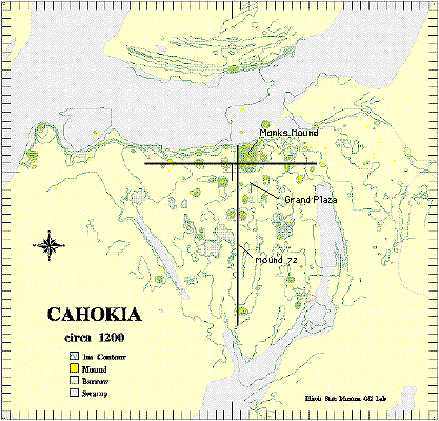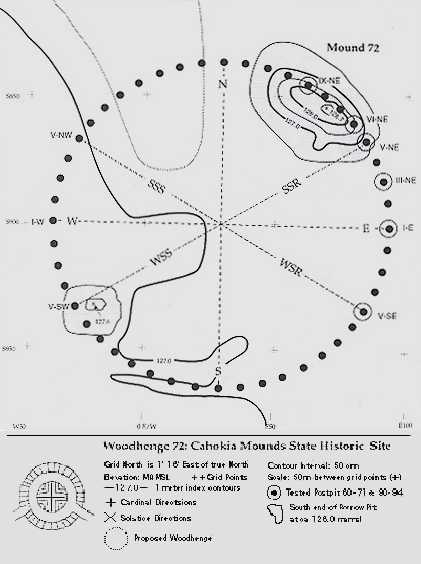
Map showing the cross-like layout of Cahokia Mounds.
|
Perhaps what is most remarkable about many mounds at Cahokia is Melvin Fowler's
argument that their placement seems to have been planned according to the four
cardinal directions (in particular the equinox sunrise and sunset) and specific
celestial events, the winter and summer solstices. In essence Cahokia appears
to have been laid out like a cross with Monks Mound forming the northern arm
(intersecting the conical mound on the first terrace), the eastern and western
arms formed by a line of smaller mounds that correspond to a line of site from
the equinox sunrise and sunset, and the southern arm bisected by the Grand
Plaza.
|

Location of Woodhenge 72, Cahokia Mounds. The design
at the left of the key is a stylized
woodhenge engraved on a beaker associated with Circle 2 at Cahokia.
|
Mound 72, a small ridge-topped mound, contains dramatic evidence that celestial
events governed placement of some mounds. Here large post molds where timbers
of a large woodhenge once stood have been discovered at the mound base. This
fact indicates that the woodhenge, a circle of large poles used to track
celestial bodies and seasonal events, was in place before the construction of
Mound 72. What is most intriguing is that the post mold found under the oldest
part of the mound nearest the elite individual (laid to rest on a bed of shell
beads), is the location of a timber that would have marked the summer solstice
sunrise 400-500 years ago. It would seem that there was a religious or ritual
meaning for the placement of the elite burial and evidence for rites of renewal
marked by the summer solstice. Additions to the mound seem to follow other
posts of this ancient woodhenge, giving Mound 72 its unique southeast to
northwest orientation. The importance Mississippians place on woodhenges may
also be reflected in their stylized depiction as part of the cross-in-a-circle
motif on what appear to have been ceremonial beakers.
|

